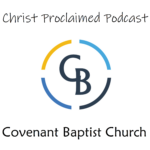“Peter Sets The Stage For The Purpose Of The Letter” sermon (2 Peter 1:1-2)


“Peter Sets The Stage For The Purpose Of The Letter” is a sermon preached from 2 Peter 1:1-2 by Noah Olguin, pastor of Covenant Baptist Church in New Berlin, Wisconsin – a confessional Reformed Baptist church subscribing to the 1689 London Baptist Confession of Faith.
Today we begin our study in Second Peter, after concluding our look at the first letter in the Petrine corpus. Aside from both letters bearing Peter’s name, many scholars believe that is where their similarities end. While First Peter is among the 22 New Testament books universally recognized as canonical, there has been disagreement over Second Peter. As we examine the reception of the canon, we classify Second Peter as a “disputed book.”
The historian Eusebius notes that by the 4th century, most of the early church had accepted Second Peter as Scripture. Michael Kruger, a New Testament professor and academic dean at Reformed Theological Seminary, argues in his book Canon Revisited that no book had a more difficult journey into the canon than Second Peter.
Today, Second Peter is widely regarded as pseudonymous, with many scholars dating it to the early 2nd century. Even John Calvin, in his commentary on Second Peter, acknowledges the disagreements about its authorship. While he notes stylistic differences between the two letters, Calvin concludes that Peter authored it, though it may have been written by a disciple under Peter’s direction due to his old age. Other scholars, like Michael Kruger and Thomas Schreiner, argue for traditional authorship and an earlier date.
One argument for traditional authorship is external evidence. For example, First Clement (96 AD) quotes or refers to material in Second Peter, showing the letter’s early existence. Early church fathers ultimately accepted it as the Word of God.
The internal evidence is also compelling. The author identifies himself as Simeon Peter, an uncommon form of Peter’s name used only once elsewhere in the New Testament (Acts 15:14). A forger would likely use the more common “Peter” to convince readers. Additionally, the author claims to have been an eyewitness to the Transfiguration and to know of his impending death, as foretold by Jesus. Such personal details suggest authenticity.
If someone were forging a letter, they would likely borrow heavily from First Peter to establish continuity, but Second Peter addresses entirely different topics. This supports the argument that stylistic differences between the letters are due to their distinct purposes. First Peter addresses one issue, while Second Peter addresses another, naturally resulting in varied styles.
If Peter authored this letter, it must have been written before his death under Nero, whose reign ended in 68 AD. This places the writing of Second Peter around 66–67 AD.
Regarding its recipients, the letter does not specify a particular audience. However, in 3:1, Peter refers to it as his second letter to the same audience. If this is a follow-up to First Peter, it was written to the “elect exiles of the dispersion” in Asia Minor, comprising both Jewish and Gentile believers.
Simon Kistemaker outlines three purposes for the epistle:
- Encouraging spiritual growth (Chapter 1)
- Opposing false teachers (Chapter 2)
- Preparing for the end of the world and judgment (Chapter 3)
Peter, knowing his life was nearing its end, sought to equip Christians to persevere and grow in faith. He intended to prepare them to resist false teachers and remain steadfast in the truth, confident in Christ’s return and the final judgment.
Peter’s opening greeting reflects the purpose of the letter, structured under three key reminders:
- Believers are reminded of who they are.
- Believers are reminded of what they have.
- Believers are reminded of what they need.
Through these reminders, Peter calls his audience to stand firm in faith, ready for the challenges ahead.
Point One: Peter Reminds Believers Who They Are
Let’s turn to verse one, where Peter addresses the Christians as “Simeon Peter” or “Simon Peter.” Why does Peter use this name?
“Simon” was the name given to him at birth by his parents, the name Jesus used when He first called him from the sea in Mark 1:16. Later, in Mark 3:16, Jesus gave him the name “Peter.” These two names reflect Peter’s identity before and after Christ. “Simon” represents his former ignorance, who he was apart from Christ. “Peter” signifies who he became in Christ, as Jesus honored him with a new name through faith.
By addressing himself as Simon Peter, Peter reminds Christians never to forget who they were before coming to Christ. Forgetting this can lead to pride. Paul demonstrates this in Acts 22 when he recounts his former life as a persecutor of the church before sharing how Christ transformed him. Both Peter and Paul stress this point to keep believers humble and thankful, recognizing that who they are is entirely by God’s grace.
Peter goes on to describe himself as a servant and an apostle of Jesus Christ.
The Title of Apostle
Peter uses this title to establish his authority, showing that his message comes directly from God. The term “apostle” means messenger or delegate—someone commissioned to speak on behalf of another. Apostles were few, directly called by Christ, and uniquely gifted to declare God’s word and verify it through signs.
The Title of Servant
While only a small number were apostles, every Christian is a servant of Jesus Christ. This is why Peter first identifies as a servant, aligning himself with all believers.
In 1 Peter 5, when addressing elders, Peter identifies as a “fellow elder,” not emphasizing his apostolic authority. Here, by calling himself a servant, Peter connects with all Christians, affirming their shared calling to serve Christ.
The Purpose of the Letter
Peter’s purpose becomes clear in verses 12–14 of chapter 1:
“I intend always to remind you of these qualities, though you know them and are established in the truth you have. I think it right, as long as I am in this body, to stir you up by way of reminder, since I know that the putting off of my body will be soon, as our Lord Jesus Christ has made clear to me.”
Peter knows his time is short. This letter is a call for Christians to persevere and grow in faith, resisting false teachers. By referring to himself as a servant, Peter emphasizes that all Christians are called to live in faithful obedience.
Living as Servants of Christ
In 1 Corinthians 7:22–23, Paul reminds believers that they were “bought with a price” and are therefore servants of Christ. Peter urges believers to consider his life as an example, using everything he had for the glory of God.
As servants, we are called to glorify God in all we think, say, and do. Peter explains how believers are equipped to do this in verses 3–11:
“His divine power has granted to us all things that pertain to life and godliness, through the knowledge of Him who called us to His own glory and excellence, by which He has granted to us His precious and very great promises…”
Peter exhorts believers to confirm their calling and election by practicing qualities like faith, virtue, knowledge, self-control, steadfastness, godliness, brotherly affection, and love. These qualities help believers resist false doctrine and remain fruitful in their knowledge of Christ.
Overcoming False Teachers
Peter teaches that living as servants of Christ protects us from false teachers. By serving Christ, rather than our own desires or others’ teachings, we fulfill our calling.
In verse 11, Peter reminds us of the eternal reward for faithful service:
“There will be richly provided for you an entrance into the eternal kingdom of our Lord and Savior Jesus Christ.”
Peter contrasts this eternal perspective with worldly ambitions. Many strive for fame or wealth, but Peter emphasizes the honor of being called a servant of Christ. This title, bestowed by Christ, is worth more than anything the world can offer.
This leads to Point Two, where Peter describes what is common to all servants of Jesus Christ.
Point Two: Peter Reminds Believers What They Have
In verse one, Peter writes:
“To those who have obtained a faith of equal standing with ours by the righteousness of our God and Savior Jesus Christ.”
Equal Standing in Faith
When Peter speaks of “a faith of equal standing with ours,” referring to the apostles, he does not mean equal in degree. We know from Scripture that faith varies in strength. Paul acknowledges this in Romans 14:1: “As for the one who is weak in faith, welcome him.” Faith can range from weak to strong.
What Peter means is that all who believe in Christ share a faith of the same nature. It is not about the quantity of faith but its quality. All Christians possess faith in the same Christ, and the nature of that faith is the same because it lays hold of the same benefits in Christ.
This truth should be a source of great thanksgiving, especially during times of weakness in faith. There are no second-class citizens in the kingdom of God. God does not love those with stronger faith more than those with weaker faith. Even when our faith is weak, we are fully loved, and we receive the same blessings, privileges, and rewards that Christ has secured for all His people.
How amazing is it to know that even with faith as small as a mustard seed, we share equal standing with the apostles and can take equal comfort in Christ’s promises.
Faith Rooted in God’s Righteousness
Peter makes it clear that this faith is not earned through human effort. He writes that it is “by the righteousness of our God and Savior Jesus Christ.” This refers to God’s saving righteousness, often paralleled with salvation in the Old Testament. For example, Psalm 22:31 states:
“They shall come and proclaim His righteousness to a people yet unborn, that He has done it.”
Peter emphasizes that our faith is rooted not in ourselves but in the saving righteousness of God revealed in Jesus Christ. It is a free gift of salvation, promised to Abraham in Genesis 12, proclaimed by the prophets and apostles, and fulfilled by Christ through His death on the cross.
The Divinity of Christ
Peter’s phrase “our God and Savior Jesus Christ” is a clear affirmation of Christ’s divinity. Some argue that “God” and “Savior” refer to two distinct persons, but the grammar indicates otherwise. If Peter intended to distinguish between the two, he would have written, “our God and our Savior Jesus Christ.” Instead, he uses one article for both nouns, indicating that they refer to the same person: Jesus Christ.
We see the same grammatical structure in verse 11:
“For in this way there will be richly provided for you an entrance into the eternal kingdom of our Lord and Savior Jesus Christ.”
Here, “Lord” and “Savior” both clearly refer to Christ. Likewise, in verse one, “God” and “Savior” refer to the same person: Jesus Christ.
Thanksgiving for Faith and Salvation
Peter highlights that only because Jesus is both God and Savior can we have forgiveness, righteousness, reconciliation with God, and salvation. This salvation is not earned by us but is entirely by God’s grace and Christ’s righteousness.
What a relief it is to know that our faith’s standing is not based on our efforts but on the righteousness of our God and Savior Jesus Christ!
Faith as a Distinction from False Teachers
As the letter progresses, Peter will address false teachers who promote antinomianism—the idea that behavior does not matter for those under grace. By contrast, Peter emphasizes that true faith, obtained through Christ’s righteousness, is living and active. This faith sets believers apart from false teachers and their destructive doctrines.
Peter urges believers to remain steadfast in what they have been taught, holding firm to the truth. By doing so, they will stay on the path of righteousness and avoid forsaking Christ.
The Blessing of Grace and Peace
Peter concludes the greeting in verse two:
“May grace and peace be multiplied to you in the knowledge of God and of Jesus our Lord.”
This leads us to our third and final point: Peter Reminds Believers What They Need.
Point Three: Peter Reminds Believers What They Need
The Benediction’s Purpose
Why does Peter add the benediction, “May grace and peace be multiplied to you,” at the start of his letter? It aligns with the purpose of the letter: to rouse believers to perseverance and faith. Peter knows false teachers aim to deceive and destabilize their souls. He wants believers to focus on Christ’s return and the final day of judgment.
How will they endure to the end? How will they overcome the deceptive teachings and resist temptations? The answer lies in the grace and peace of God. Peter prays for these to be multiplied because they are essential for sustaining believers throughout their lives.
Grace and Peace: All-Encompassing Blessings
William Ames explains that “grace” refers to both God’s free favor and its application in the hearts of believers through the Holy Spirit, while “peace” is the quietness of mind that flows from grace. Grace is the first blessing, peace the final one, and everything in between falls under their umbrella.
When Peter prays for grace and peace to be multiplied, he is asking for an abundance of all spiritual blessings. This prayer teaches believers to hunger and thirst for grace and peace, not only for themselves but also for others. Peter’s example reminds us to pray for these blessings to be multiplied in the lives of our brothers and sisters in Christ.
A Call to Continual Growth
By asking for grace and peace to be multiplied, Peter reminds believers of the need to seek greater abundance in all spiritual good things. They must not rest in their current experience of grace and peace but pursue growth through diligent study and deeper knowledge of God and Christ.
Peter writes, “Grace and peace are multiplied in the knowledge of God and of Jesus our Lord.” This theme permeates his letter. In 2 Peter 3:18, he concludes with a similar exhortation: “But grow in the grace and knowledge of our Lord and Savior Jesus Christ.” This growth is crucial for combating sin, false teaching, and the devil’s schemes.
Knowledge: Head and Heart
Peter emphasizes both intellectual and experiential knowledge of God. While understanding doctrine is vital, believers must also deepen their relational experience with God in Christ. True knowledge is both understood and felt, shaping both heart and mind.
Christ: The Source of Grace and Peace
All grace and peace flow from Jesus Christ. No one can approach God the Father apart from Christ. Without Christ, the Father is a God of wrath and judgment. Through Christ, believers receive spiritual blessings, comfort, and peace. Christ serves as the channel through which these blessings flow, and believers must continually seek them in prayer, trusting God’s willingness to provide.
The Letter’s Purpose
This greeting outlines the purpose of Peter’s letter. False teachers were trying to lead believers astray, encouraging them to disregard sound doctrine, live sinfully under the guise of grace, and dismiss the second coming of Christ and final judgment.
Peter writes to counter this deception by reminding believers:
- Who They Are – Servants of God and Jesus Christ.
- What They Have – A faith of equal standing with the apostles.
- What They Need – The continual multiplication of grace and peace throughout their lives.
Peter’s goal is to encourage believers to persevere in faith and remain steadfast until Christ returns to judge the living and the dead.

Leave a Reply